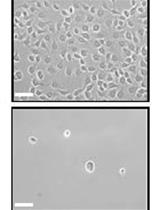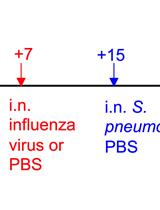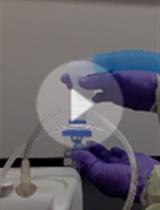- EN - English
- CN - 中文
Human Blood Component Vaccinia Virus Neutralization Assay
人的血液成分与牛痘病毒的中和试验
发布: 2015年12月05日第5卷第23期 DOI: 10.21769/BioProtoc.1674 浏览次数: 8772
评审: Lee-Hwa TaiElizabeth V. ClarkeAnonymous reviewer(s)
Abstract
Many therapeutic viruses, such as oncolytic viruses, vaccines, or gene therapy vectors, may be administered by the intravenous route to maximize their delivery to target tissues. Blood components, such as antibody, complement and blood cells (such as neutrophils, monocytes, T cells, B cells or platelets) may result in viral neutralization and therefore reduce the therapeutic efficacy. This protocol will describe an in vitro assay by which to test the interaction of viruses with blood components. The effect of various factors can be isolated through fractionation. While whole blood can offer the most physiologically relevant snapshot, plasma can investigate the effects of antibody in concert with complement, and heat inactivated plasma will interrogate the effect of antibody alone.
Keywords: Complement (补充)Materials and Reagents
- BD Vacutainer 7 ml Glass Serum Tubes, No Additive, Silicone-Coated Interior (BD, catalog number: 366431 )
- Eppendorf tubes (1.5 ml)
- T175 cm2 culture flasks (Corning Inc., catalog number: 431079 )
- 12-well plates culture plates (Corning Inc., catalog number: 3513 )
- 15 ml Falcon tubes (BD Biosciences, Falcon®, catalog number: 352096 )
Note: Currently, it is “Thermo Fisher Scientific, FalconTM, catalog number: 352096 ”. - Insulin syringes 27G1/2” (Terumo Medical Corporation, catalog number: SS05M2713 )
- 0.22 μm Millipore® StericupTM filter unit (Merck Millipore Corporation, catalog number: SCGPU05RE )
- Alcohol wipes
- U2OS human osteosarcoma tumor cells (ATCC), grown in complete DMEM (10% FBS)
- Vaccinia virus stock ≥ 5 x 106 pfu/ml
- 1x sterile phosphate-buffered saline (PBS) (Hyclone, catalog number: 21-031-CV )
Note: Currently, it is “Mediatech, Inc., Corning, catalog number: 21-031-CV ”. - Fetal bovine serum (FBS) (Sigma-Aldrich, catalog number: F1051 )
- Dulbecco’s modified Eagle medium (DMEM) culture media (Hyclone, catalog number: 10-031-CV )
Note: Currently, it is “Mediatech, Inc., Corning, catalog number: 10-031-CV ”. - 2x DMEM powder (Life Technologies, catalog number: 12800-017 )
Note: Currently, it is “Thermo Fisher Scientific, GibcoTM, catalog number: 12800-017 ”. - Carboxymethylcellulose (CMC) (Sigma-Aldrich, catalog number: C5678-1KG )
- Sodium bicarbonate (Thermo Fisher Scientific, catalog number: S233-500 )
- 100x Penicillin-Streptomycin (GE Healthcare, Hyclone, catalog number: SV30010 )
- Refludan (Lepirudin)
- Crystal violet (Sigma-Aldrich, catalog number: C0775 )
- Methanol (Thermo Fisher Scientific, catalog number: A412P-4 )
- 2x DMEM solution (see Recipes)
- 3% Carboxymethylcellulose (CMC) (see Recipes)
- Titration overlay media (see Recipes)
- Crystal violet (see Recipes)
Equipment
- Centrifuge (Thermo Fisher Scientific, model: ST40R )
- Biosafety cabinet
- 37 °C, 5% CO2 incubator (Sanyo)
- ViCell (Beckman Coulter) or hemocytometer cell counter
- pH meter
- Heat blocks set to 37 °C and 56 °C
- BD Vacutainer® Push Button Blood Collection Set with Pre-Attached Holder (example 25G x 0.75 in) (BD, catalog number: 367336 )
Procedure
文章信息
版权信息
© 2015 The Authors; exclusive licensee Bio-protocol LLC.
如何引用
Evgin, L. and Bell, J. (2015). Human Blood Component Vaccinia Virus Neutralization Assay. Bio-protocol 5(23): e1674. DOI: 10.21769/BioProtoc.1674.
分类
癌症生物学 > 肿瘤免疫学 > 癌症治疗
免疫学 > 补体分析 > 病毒
免疫学 > 宿主防御 > 人
您对这篇实验方法有问题吗?
在此处发布您的问题,我们将邀请本文作者来回答。同时,我们会将您的问题发布到Bio-protocol Exchange,以便寻求社区成员的帮助。
提问指南
+ 问题描述
写下详细的问题描述,包括所有有助于他人回答您问题的信息(例如实验过程、条件和相关图像等)。
Share
Bluesky
X
Copy link













